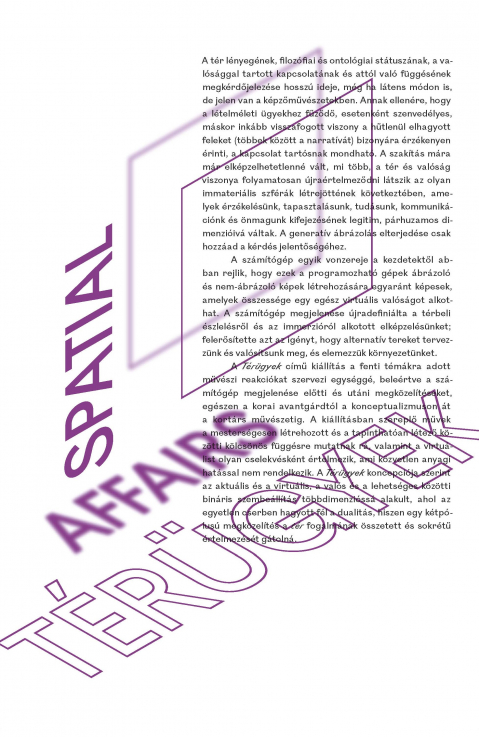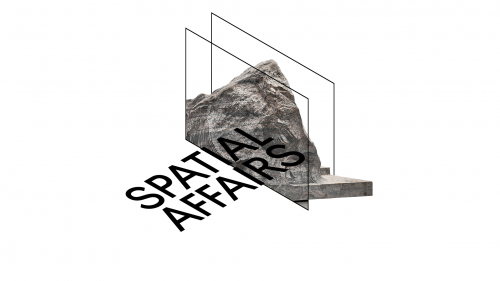The publication Spatial Affairs the Reader has in their hands is a product of a complex and special project. It accompanies the exhibition Spatial Affairs (29 April – 27 June 2021) in Ludwig Museum – Museum of Contemporary Art in Budapest, and its digital extension, Spatial Affairs. Worlding. The exhibition Spatial Affairs appears both as a physical exhibition in the Ludwig Museum, and is also available online. The complementation of Spatial Affairs, digital extension Spatial Affairs. Worlding, is available online on the websites of the Beyond Matter project and EPFL Pavilions, Swiss Federal Institute of Technology Lausanne.
The cover of this volume contains a SHORT CONCEPT of the exhibition (repeated shortly after the Editorial) complemented by the double frame, a Spatial Affairs motif, to be found also elsewhere inside the book. Along with the TABLE OF CONTENTS the following elements make up the opening of this catalogue: the FOREWORD by Julia Fabényi, the director of Ludwig Museum – Museum of Contemporary Art in Budapest, and this EDITORIAL, a short guide through this publication. Further, the structure of the catalogue aims to correspond with the complexity of the exhibition.
The text “BEYOND MATTER AND SPATIAL AFFAIRS: AN INQUIRY INTO SPACE IN THE VIRTUAL CONDITION” by Lívia Nolasco-Rózsás, one of the curators, and at the same time the initiator and head of BEYOND MATTER, puts the Spatial Affairs in a wider context, presenting the premises of the project—contraposing the cultural heritage and culture with virtual reality—from which this exhibition has arisen. Next, two curatorial texts follow, letting us delve deep into the world of Spatial Affairs, opening to us a multitude of this project’s aspects: “RENDERING THE DIGITAL PENUMBRA AND ITS TRANSLUCENCE” by Giulia Bini and “IN SPATIAL TERMS” by Lívia Nolasco-Rózsás. The curators present here their theoretical points and explain profoundly the methodology behind Spatial Affairs.
Three original ESSAYS by Adam Lovasz, Sven Lütticken and Ceci Moss were commissioned by the curators especially for this book. They constitute the next section of this publication, offering not necessarily a direct response to the exhibition itself, but rather addressing its “spatial” subject in a broader context, thus enriching and broadening Spatial Affairs’ interpretative field. Adam Lovasz “KAFKA [ESC]. IMPOSSIBLE EXPERIENCES IN HYPERREALITY” takes us on a philosophical journey within the culture, pop-culture, and recent global occurrences, through the lens of hyperreality with references to Franz Kafka. The socio-political dimension of present-day global world takes on even more importance in Sven Lütticken’s essay “MISSED ENCOUNTERS IN MESH SPACE”, where the author describes today’s experience as a hybrid space, where both individuals and states, art and politics, are all entangled in what Lütticken calls a “mesh of social networks.” Finally, “JUMPING SCALES” by Ceci Moss analyzes the works from the exhibition while asking a question about the relationship of the image production and technology.
An interesting component merging both the exhibition and this catalogue are original texts, partly written by artists, partly by theoreticians, collected in the section MANIFESTOS. In the book they appear in chronological order to help embracing the art-spatial attitudes in time, starting from the text by great avant-garde figures (Katarzyna Kobro and Władysław Strzemiński’s Composing Space / Calculating Space—Time Rhythms from 1931) to authors publishing in the most recent times (the newest being The Dark Forest Theory of the Internet by Bogna Konior from 2020). While in the exhibition space these excerpts mingle with artworks, here they provide a document- like extension to Spatial Affairs’ conceptual and theoretical papers.
ARTWORKS constitute the next section, including short descriptions and images of the artworks presented at the physical exhibition Spatial Affairs and of those being part of its digital extension, Spatial Affairs. Worlding. Here, the catalogue contains the AR (Augmented Reality) extensions—markers developed by Transbooking, a feature being a rare practice for an art book.
The structure of Spatial Affairs catalogue aims not only to capture the complexity of the spatial issues undertaken by the exhibition, but also to reflect upon the hybrid nature of the whole project. It wishes to reveal its triangular nature: physical, digital (online), and augmented—being three spatial realities in the strange times of Covid pandemic situation in 2021.
(Editorial by Jan Elantkowski)
Language: Hungarian

